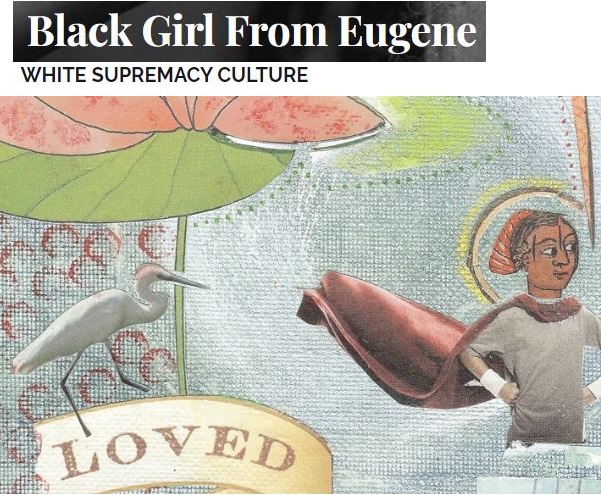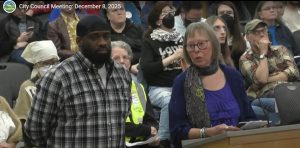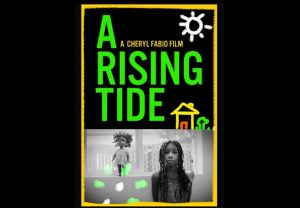Black Girl From Eugene: The 15 tenets of white supremacy culture
14 min read
KEPW features the program Black Girl From Eugene with Ayisha Elliott every Sunday morning at 11. Here are excerpts from her Dec. 24 broadcast: The characteristics of white supremacy culture.
Ayisha Elliott: This is Ayisha Elliott, and you’re listening to Black Girl From Eugene. I am going to talk to you all about white supremacy culture and more specifically the tenets or characteristics of white supremacy culture.
[00:00:26] Originally, when I was doing my research on this idea, I came across this amazing list of characteristics, which are really, really well known at this point. The research originally was about organizations and the workplace, right? Culture/organizational culture. And the list that I use, researchers Kenneth Jones and Tema Okun came up with.
[00:00:51] I like to use their list because it’s super, super comprehensive. They also have antidotes to it, although the antidotes are brief and they are not exclusive, and it’s always very much tied to organizational solutions.
[00:01:04] So my take on this is that the United States, my friends, is a corporation. Capitalism runs the deal in the United States, no matter what. It’s always money over people.
[00:01:14] So, the idea is that the product is the most important thing. And so, for me, I feel like when you are socialized into a colonized society, especially one so strictly based in capitalism like the United States, most of your existence kind of runs like you’re just a piece of a corporation, right?
[00:01:34] Your own personal experiences aren’t really the point of your existence or your coexistence with people with you.
[00:01:41] So that’s why I love to utilize this list that these two researchers came up with because it extrapolates really well to our personal connections to each other and where we think the others how they fit in and how they don’t fit in.
[00:01:57] The most important part is how you react to when other people don’t have that same expectation or that same characteristic. That’s the part where we start to place value on the folks who are not aligned to this expectation.
[00:02:13] The truth of the matter is, these characteristics are really, really highly tied to colonized culture, which means most of the Black and brown world do not naturally fit. This does not naturally fit into everyday relational ideas. The opposite of this kind of transactional culture is relational culture.
[00:02:35] So, the characteristics of white supremacy culture, I’m just going to go through a quick list, like I said. There’s 15 of them, and I’m just going to name them off:
[00:02:42] First, (1) perfectionism. Little appreciation expressed among people for the work that others are doing. More common is to point out either how the person is working or how the person’s work is inadequate. How they show up is inadequate. That’s just a couple of them.
[00:03:00] And then we’ve got (2) sense of urgency. This continued sense of urgency makes it difficult to take time to be inclusive, encourages democratic and/or thoughtful decision making, to think long term or to consider consequences.
[00:03:16] So the sense of urgency frequently results in sacrificing potential allies for quick and highly visible results. Think about this. Think about your work. Maybe you’re a coach of a Little League team. Maybe you are a teacher in a classroom. Perhaps you are a, I don’t know, news editor.
[00:03:35] ‘Frequently results in sacrificing potential allies. For example, sacrificing interest of communities of color in order to win victories for white-bodied people.’ And that was also seen as a default to a norm or a norm community, which, you know, is problematic already, having the default be a white-centered perspective.
[00:03:55] Coming from that space, we’ve got (3) defensiveness. An organizational structure is set up with a lot of energy spent trying to prevent abuse and to protect power as it exists rather than to facilitate the best out of each person and to clarify who has power and how they are expected to use it.
[00:04:16] That’s one of the points of defensiveness. People respond to new or challenging ideas with defensiveness, making it a difficult space to raise ideas. And a lot of energy is spent on this because of either/or thinking. Criticism for those with power is viewed as threatening and inappropriate or rude, or out-of-pocket, right?
[00:04:44] So we’re moving on to (4) quantity over quality. All resources are directed towards producing measurable goals, things can be measured as either highly valued and things that cannot. For example, numbers of people attending a meeting, a new circulation, money spent are valued more than: the quality of relationships, democratic decision-making, or ability to constructively deal with a conflict.
[00:05:09] Along with the quantity over quality, there’s also an innate discomfort with emotions and feelings.
[00:05:16] (5) Worship of the written word. I love this one because people like when you try to create an organization and you’re trying to create an inclusive one and they’re like, ‘Well, we need to document,’ you’re like, ‘Well, how do you do that without worshiping the written word?’
[00:05:29] Well, the idea is that you’re not analyzing how people inside and outside of the organization get that information. An organization or people do not take into account the value of other ways in which information can be shared, right? If it’s not in a memo, if it’s not in an email, it didn’t exist.
[00:05:46] I mean, I could go really far into the way indigenous people of all culture, of all nations, of all parts of the world have never written down their stories and because of that have been absolutely erased, and the storykeepers of those folks have very, very detailed accounts. Yet without it being in the written word, the default culture considers it to be not relevant, right?
[00:06:13] Okay. We’re moving on. (6) Only one right way. Now, this is really interesting because if you think about it, if you had an inclusive space and you had a sense of belonging, there could not possibly be one way to do it. But this also leans into people’s sense of urgency and defensiveness, right?
[00:06:31] Mind you as we go through this, none of these are standalone. The idea of standing alone in one space is a very white-bodied, white-supremacy-cultured idea. These all relate to each other and feed off each other. It’s liquid.
[00:06:47] So only one right way. The belief there is one way to do things. And once people are introduced to that right way, they will see the light. They will then understand that they have been wrong this whole time, and they will adopt it wholeheartedly.
[00:07:00] When they don’t adapt to change, something is absolutely wrong with them. It’s like the idea of like, not necessarily wrong with them, as in ‘Oh, the information wasn’t given in the right way,’ but characteristically, there’s something wrong with them.
[00:07:14] Moving on to (7) paternalism. Decision-making is clear to those with power and unclear to those without. That is super important because paternalism is something that a lot of folks throughout the world just don’t question. It just is what it is. It’s how it’s always been. I don’t know where it goes. It just works.
[00:07:34] Those are all quietly problematic when you’re talking about inclusivity. Those with power think they are capable of making decisions for, and in the interest of, the people without power. And so there’s no sense of collaboration, there’s no sense of leadership from, or voice from the people who have less power.
[00:07:52] And therefore, they have no sense of how they would actually gain full power as the people who are maintaining, hoarding, and protecting that power.
[00:08:01] (8) Either/or thinking; the binary. Things are either/or. They are either good or bad. They’re either right or wrong. It is either for us or against us. I know y’all can think about this in a lot of different ways, right?
[00:08:13] This is, I think, really, all of these tenets really help to dehumanize the position of people of color and marginalized communities in such an easy way that it doesn’t allow for any kind of spectrum in between. That’s not a give and take with the binary. That doesn’t happen with the binary. It’s closely linked to perfectionism and it actually makes it super difficult to have fruitful conflict, right?
[00:08:40] And to have, it absolutely is something that I think is at the root of defensiveness, you know? There’s like no sense of intersectionality. There’s no sense of both/and. And actually both/and creates some sort of crisis.
[00:08:56] So next is (9) power hoarding, which, you know, do we need to define that? We kind of know what that is, right? But it seems like power is seen as limited. And there’s definitely no value in sharing power, because if everyone does it, then what’s the importance? Right? How do you know what’s important if everyone has a piece in it?
[00:09:14] Those with power don’t see themselves as hoarding power or as feeling threatened by people who want to also share space in that power. They usually feel threatened when someone suggests change and how things should be done in the organization or in their lives, right? How is that directly related to all of the things? So much.
[00:09:34] John Q: You’re listening to Ayisha Elliott, from her Dec. 24 edition of Black Girl From Eugene, as she shares the 15 characteristics of white supremacy culture. Here’s number 10:
[00:09:44] Ayisha Elliott: So the next is (10) fear of open conflict. People in power and one thing in people in power, I am talking about privileged people, white-bodied people as well. But in an organizational-wise, we’re talking about the leadership team. We’re talking about people who make the decisions—the exec teams, the CEOs, all that.
[00:10:02] So when it comes to us and on our everyday, it’s people who are privileged or white-bodied people who hold the systemic power, right? So then we’ve got people of power are scared of conflict. They have this fear of open conflict. They try to ignore it. They try to run from it.
[00:10:21] And the people who raise a conflict or cause any sort of discomfort, and if you think about all the things we just listed, any sort of discomfort can literally come from anything that is out of the sights of white-bodied people, or makes them stop and pause about anything that may happen. Anyone who raises and causes any sort of discomfort, the response is to blame the person for raising the issue rather than to look at the issue itself.
[00:10:46] So there’s this whole idea of politeness and that definition of politeness is what white supremacy culture defines as polite, right?
[00:10:56] So let’s move on to (11) individualism. Individualism is something that I find really problematic because, as I listen to white folks in particular, white-bodied people in particular talk about it, I find this really, really emphasis on individualism, and it goes very much into this either/or thinking, right?
[00:11:15] I don’t see a lot of emphasis on actually having compassion and empathy for other people outside of your own emotions. But we’re also not (at least I haven’t seen a huge push towards) understanding that you have it and so do other people. Like you impact and they impact. It’s both/and, right?
[00:11:34] So anyway, the sense of individualism has this individual recognition and credit. It leads to isolation. People in organizations believe that they are responsible for solving the problem alone. And so really what happens with individualism on all parts and sorts is that it creates a lack of accountability.
[00:11:55] People are able to get credit for ‘doing the work alone’ and we know, right, that there’s usually not ‘an alone’ getting the work done. There’s other people and parts in it.
[00:12:06] (12) I’m the only one is obviously connected to individualism, and there’s no ability and no desire to delegate, and no desire to think of the community as part of the solution to whatever you’re doing.
[00:12:20] Bigger. (13) Progress is bigger. It’s more progress of an organization or of your own self-initiative, develops the ability to serve more people. But it doesn’t really matter how well you’re serving them.
[00:12:32] So it’s kind of like the same idea, like, you’re relating to more people, you’re getting people in, you can’t remember their names, right? So it gives no value to a relational concept. Those we serve may be exploited, excluded, or underserved as we focus on how many we are serving, instead of the quality of service or values created by the ways in which we serve.
[00:12:56] That one’s a kind of a deep one and I think it’s really super important to understand how well it ties to urgency, how well it ties to one way, how well it ties to the fear of open conflict and how it would absolutely be a barrier to inclusivity.
[00:13:11] (14) Objectivity is one I’ve been focusing on with a couple groups of mine, and I love this subject matter because it goes so deep into so many ways that we dehumanize each other. And it’s very easy to dehumanize someone if the product should have an objective view, and only an objective view, especially when the product has to do with whole communities, right?
[00:13:31] So the belief that there is such a thing as being objective, first of all, we’re human beings. So ‘the belief that emotions are inherently destructive, irrational, and should not play a role in decision-making for a group process, invalidating people who show emotion.’ We could go very deep into this, can we not?
[00:13:47] This goes a long way into policy, politics, but it goes a long way into our personal relationships and how we see other folks in the spaces that we share and that we call, and I’m air-quoting, ‘professional,’ right?
[00:14:00] (15) The right to comfort. The belief that those with power have the right to emotional and psychological comfort, as valuing logic over emotion, so equating individual acts as unfairness against white-bodied people, with systemic racism which daily targets people of color.
[00:14:18] So I feel like the right to comfort is something that shows up in this idea that when people are like calling out Karens and calling this ownership of the system that white-bodied people and privileged people don’t see themselves as protecting, and then utilizing the system to call upon the system to uphold their right, what they believe to be innately their space, to have an expectation of what that space looks like, when people of color do not have that same expectation.
[00:14:44] Anyway, I hope this was enlightening for you. I know I’m talking super fast as I do, but the thing about these tenets is when we don’t recognize that we’re practicing them, when you have people who don’t assimilate well to this, or have some sort of other level of being or understanding or coming to the work, it’s like: What is your response or your organization’s response or your personal response to how they show up differently?
[00:15:12] Now, I know most good-doers and white-bodied people, especially white-bodied female people, would go, ‘I would never do that! Oh my gosh, if someone comes to me, and they speak another language, and they have another way of doing things, I would go to wherever they come from and bring everyone over and have them all do this thing.’
[00:15:29] And the truth of the matter is, never at that point did we actually bring in the people who are representing the solution to take charge of that solution, take charge of that change, have actual authority over that part.
[00:15:42] It’s a challenge because the normative conversation is white. So people who can speak that language and who can align themselves to these tenets are more successful, right? Black and brown people have a relationship to these tenets and we have a deconstruction to these tenets as well.
[00:16:01] Our relationship to these tenets is different, obviously, and the white-bodied people have a relationship to these tenets that I think is more implicit. But there’s, like I said before, the Black and brown people have this implicitly as well, and have expectations amongst our own communities that lie right within these white supremacy culture tenets that don’t allow us to actually come together as a community.
[00:16:23] When I talk about these tenets and I look at folks having a hard time bringing in and creating an inclusive environment, they don’t look at the potentiality of having different cultures represented and having leadership have authentic authority within that space. The idea that it has to be hierarchy and that it has to go from top to bottom is something that, when attached to these tenets, is almost unimaginable to believe that you can actually work in teams of people and have the same result.
[00:16:51] And actually, it’s not even the same result. The result is actually 25% – 35% more productive when you have a relational inclusive environment. So, you know, all I’m saying is that you cannot achieve these things unless you take a personal look at how you relate to not only your own awareness of your relationship to racism or how you understand that racism is a part of all of your relationships.
[00:17:16] Because that’s the way that we’ve been socialized. We’ve been socialized to understand that someone has to go second and someone who has to go second is not someone who is white-bodied. We know that. And so, and it’s obviously not one way or the other. It’s absolutely intersectional. It’s absolutely both/and. But it’s absolutely based in privilege and it’s absolutely based in maintaining that privilege and maintaining that culture that where all things feed into the other, it’s really hard to break down. It’s really hard to find the way out, right?
[00:17:50] And I don’t know if the cat’s out of the bag yet, but white supremacy culture doesn’t help white-bodied people either, you know. It really does not help to be that ignorant about the potential of literally everyone else.
[00:18:02] I teach about this all the time. I challenge businesses, and like I said, all the folks I talk to, lecturing, to ask yourself: Where in your work, where in your school, where in your profession, where in your specialty, that you are able to practice an understanding of our emotional connection to our relationship to racism—is why it’s difficult, right?
[00:18:26] So it’s definitely a challenge for white-bodied folks who sit in that, in the comfort of privilege and who sit in the comfort of denial. It’s hard because you’ve never had to share and that’s hard, right? You’ve never had to look in the mirror and then you be the one that is being examined.
[00:18:47] That’s uncomfortable. Understandably! Understandably. But I do think it helps when you don’t see the satisfaction of the community when you replace a white-bodied person with a brown-bodied person who does the same thing the white-bodied persons do. They just look different, right.
[00:19:03] It’s very possible to have a brown-bodied person completely maintain white supremacy culture and just because they’re in that space doesn’t actually change the authenticity of the space that you’re trying to create as inclusive. It’s not authentic, it’s performative, and it’s harmful.
[00:19:19] It’s because you are not actually connected to your relationship to racism. You’re not connected to it, you’re denying it, and you’re trying to pretend like it was never something that was a part of your life in the first place. And I’m trying to say that’s absolutely impossible. It would be better if you just named the elephant in the room because we can all smell it.
[00:19:43] Okay, this is Ayisha Elliott. And I do thank you for your time and support. Ciao!
[00:19:50] John Q: Ayisha Elliott, from her KEPW program Black Girl From Eugene, Sunday mornings at 11. You can support her work at Patreon, and learn more about the 15 characteristics at the website, WhiteSupremacyCulture.info.






